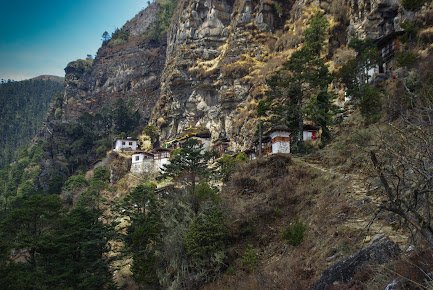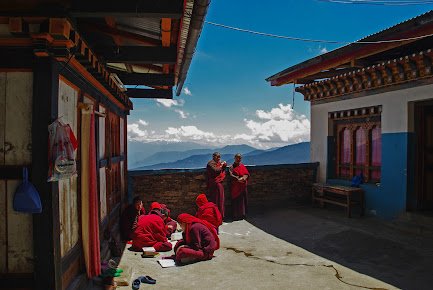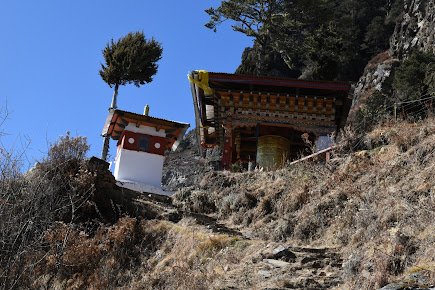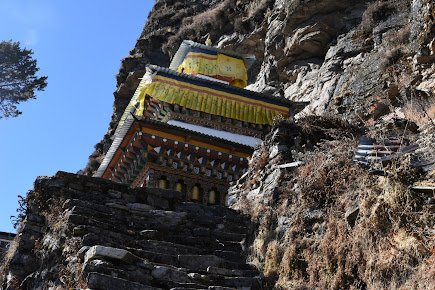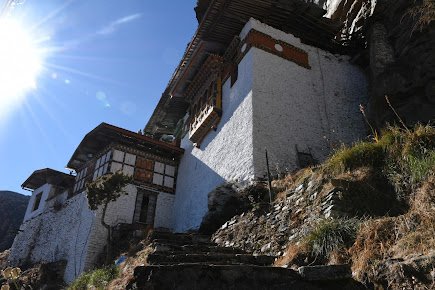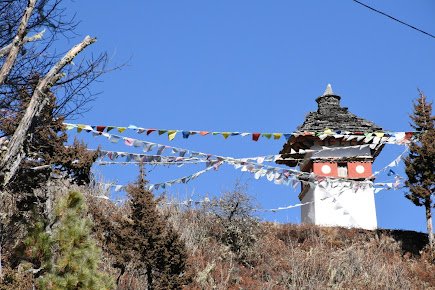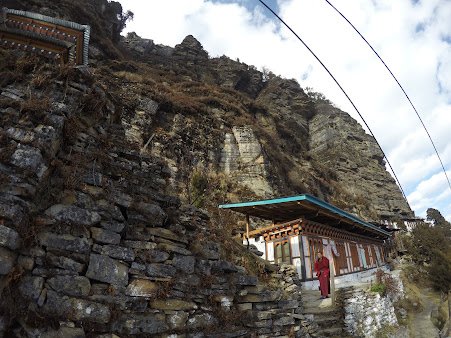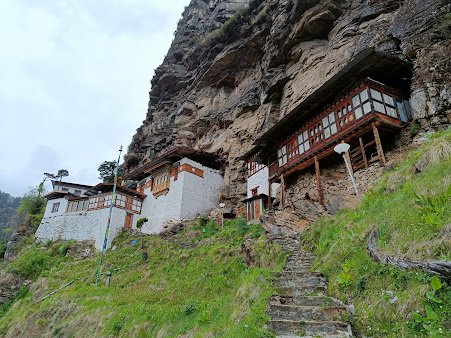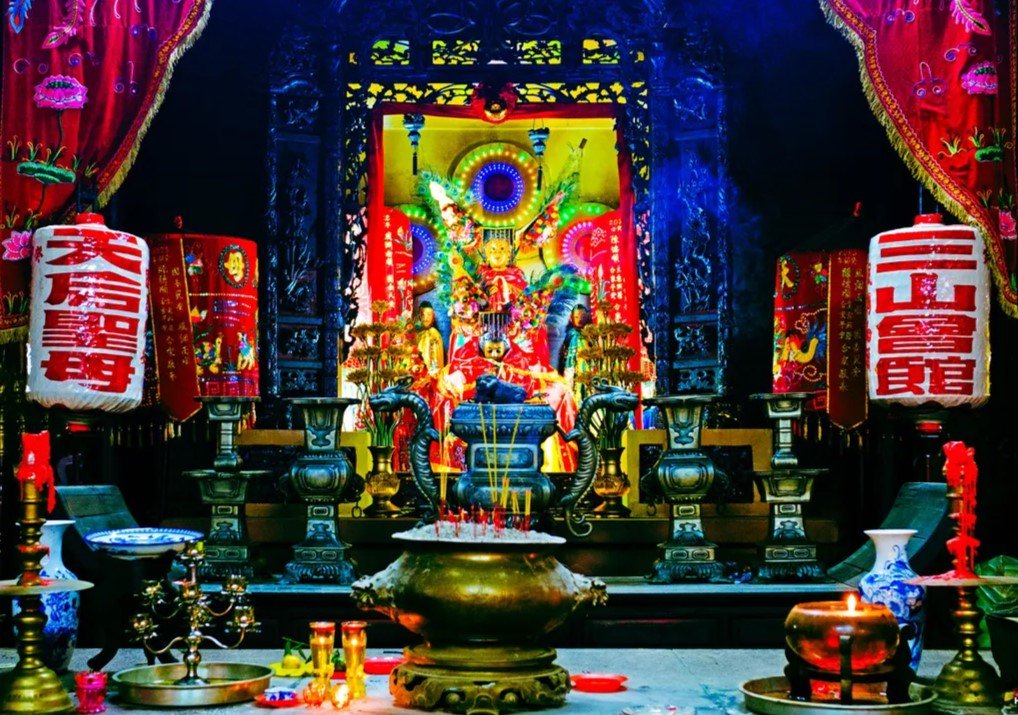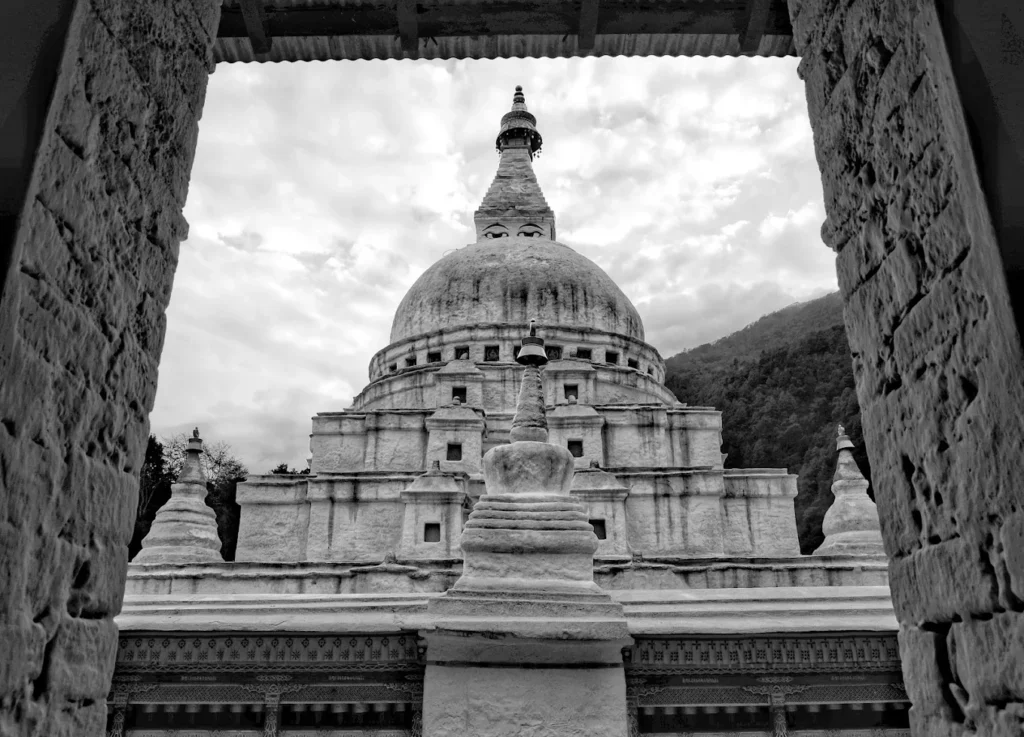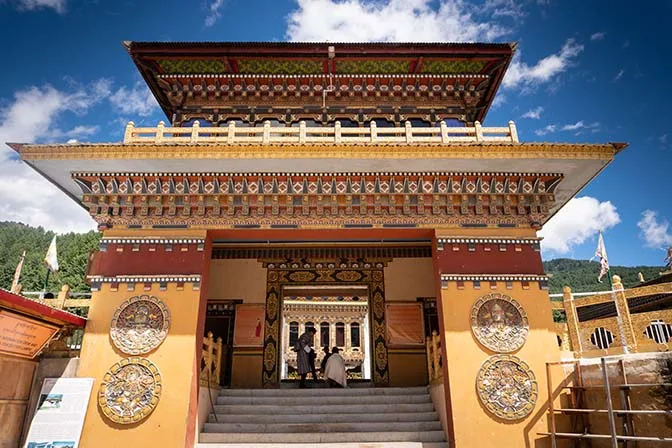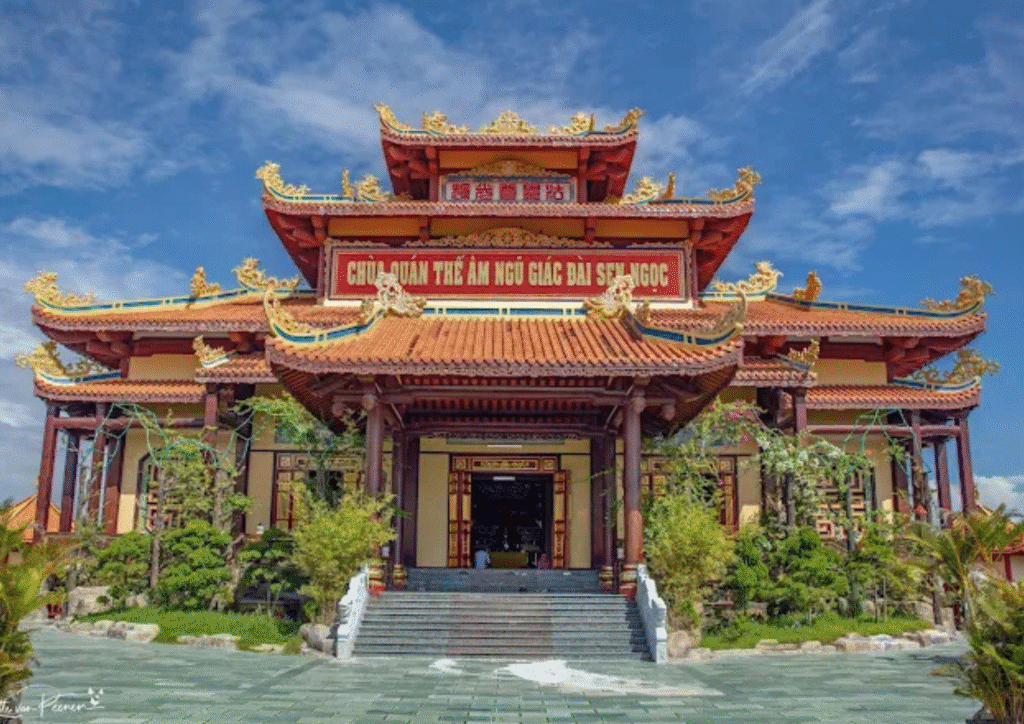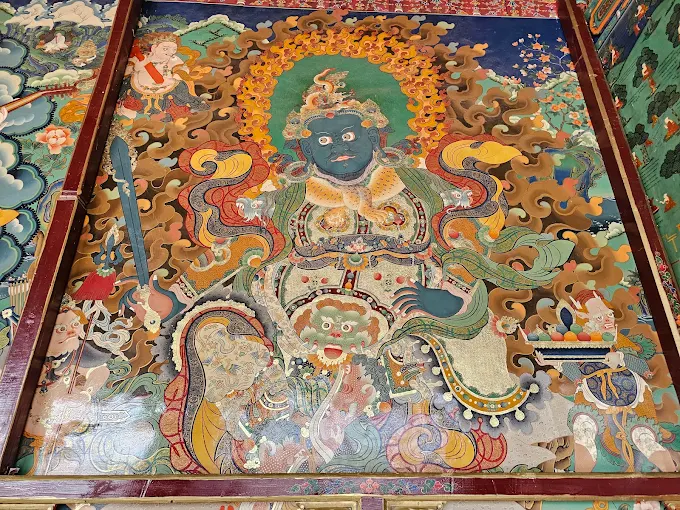Taktshang Goemba: The Sacred Echo of the Tiger’s Nest
Overview and Significance
Essence of Taktshang Goemba
Perched on the rugged cliffs of Bhutan’s Paro Valley, Taktshang Goemba is a modest yet deeply revered temple, often overshadowed by its renowned neighbor, Paro Taktsang (Tiger’s Nest Monastery). Nestled along the sacred trail to the Tiger’s Nest, this small goemba (monastery) exudes an intimate sanctity, its whitewashed walls and prayer flags resonating with the spiritual legacy of Guru Rinpoche, the “Second Buddha.” Known for its meditation caves and tranquil setting, Taktshang Goemba offers a quieter haven for pilgrims and trekkers, serving as a contemplative stop en route to the grander Taktsang. Its unassuming presence captures the essence of Bhutanese devotion, inviting those who seek solace in its humble embrace.
- Defining Trait: A serene temple tied to Guru Rinpoche’s meditation caves, near Paro Taktsang.
- Spiritual Role: A meditative retreat amplifying Bhutan’s Tantric Buddhist heritage.
- Visitor Appeal: A peaceful pause for trekkers and spiritual seekers en route to Tiger’s Nest.
Unlike the iconic Paro Taktsang, Taktshang Goemba’s smaller scale and lesser fame create a sense of discovery, with its cliffside perch offering sweeping views of the Paro Valley. The goemba’s simplicity, framed by pine forests and the distant hum of monk chants, fosters introspection, making it a cherished stop for locals and a hidden gem for visitors. Its proximity to Taktsang ties it to the same mythical narrative, yet its quieter aura sets it apart as a place of personal communion.
Historical Evolution
Taktshang Goemba’s origins are intertwined with Paro Taktsang, tracing back to the 8th century when Guru Rinpoche meditated in nearby caves, subduing malevolent spirits. The goemba itself, likely established in the 17th century during the construction of Taktsang, served as a subsidiary retreat for monks and pilgrims. Its modest structures have endured with minimal alteration, spared from the 1998 fire that devastated Taktsang. Local stewardship has preserved its authenticity, with occasional repairs maintaining its cliffside integrity.
- Key Milestones:
- 8th Century: Guru Rinpoche’s meditations sanctify the area’s caves.
- 17th Century: Taktshang Goemba established as a supporting retreat.
- 20th Century: Minor renovations reinforce mud-and-stone walls.
- Ongoing: Monks and villagers upkeep the site’s spiritual function.
Legends suggest Guru Rinpoche used Taktshang Goemba’s caves as a secondary meditation site, leaving spiritual imprints that draw devotees. Unlike larger monasteries, its history is marked by quiet continuity, with no major disasters disrupting its role. Recent efforts to stabilize the cliff path, funded by Paro’s community, ensure safe access, keeping the goemba a living part of Bhutan’s sacred landscape.
Cultural Impact
Taktshang Goemba holds a subtle but significant place in Paro’s spiritual fabric, serving as a pilgrimage stop for locals trekking to Taktsang. It is a site where villagers offer prayers for safe journeys, tying khatas to chortens in its courtyard. Though it hosts no major festivals, its role in the Taktsang pilgrimage route embeds it in Bhutan’s Buddhist culture, reflecting the nation’s reverence for sacred geography.
- Local Role: A prayer stop for pilgrims en route to Paro Taktsang.
- Cultural Symbol: Represents Bhutan’s tradition of cliffside retreats.
- Global Influence: Appeals to niche travelers seeking authentic Buddhist sites.
Globally, Taktshang Goemba is lesser-known, often mentioned in travel guides as a waypoint to Taktsang, yet its caves attract Buddhist practitioners studying Guru Rinpoche’s legacy. Its obscurity, preserved by Bhutan’s regulated tourism, enhances its appeal for those seeking unspoiled sanctity. The goemba’s cultural weight lies in its quiet service to the greater Taktsang narrative, a humble echo of Bhutan’s spiritual heart.
Signature Legacy
Taktshang Goemba’s legacy is tied to its meditation caves, believed to hold Guru Rinpoche’s spiritual energy. Locals revere a small cave within the goemba, where rock imprints are said to mark Rinpoche’s presence, drawing pilgrims for silent contemplation. The goemba’s altar, with a statue of Guru Rinpoche in his Dorje Drolo form, is a focal point for prayers, believed to grant protection to trekkers.
- Sacred Caves: Imprints linked to Guru Rinpoche’s meditations.
- Dorje Drolo Statue: A fierce yet protective icon.
- Local Tales: Stories of pilgrims finding clarity in the caves.
One tale tells of a 18th-century pilgrim who, after praying in Taktshang Goemba’s cave, dreamed of Rinpoche guiding him safely through a storm, a story still shared by Paro’s elders. These narratives make the goemba a place of spiritual refuge, its legacy woven into the Taktsang pilgrimage. Devotees leave incense at the cave, seeking to connect with its mystical power.
Community and Global Reach
Taktshang Goemba binds Paro’s rural communities, with villagers offering butter and rice to its monks, especially during Taktsang pilgrimages. The goemba’s small monastic presence, often just a few caretakers, maintains its rituals, blessing pilgrims’ journeys. Globally, it attracts trekkers and Buddhists drawn to its caves and Taktsang connection, though its fame remains niche.
- Community Engagement: Villagers support monks with offerings.
- Monastic Role: Caretakers guide rituals and bless pilgrims.
- Global Visitors: Appeals to trekkers and Buddhist scholars.
Bhutan’s diaspora honors the goemba through prayers for Taktsang pilgrims, while niche travel blogs highlight its tranquility. Conservation efforts, led by locals, focus on minimal impact, preserving the goemba’s authenticity. Bhutan’s visitor limits ensure Taktshang Goemba remains a serene stop, its reach growing quietly among those who tread its path.
Architectural Features
Distinctive Design
Taktshang Goemba’s architecture is a study in minimalist devotion, its single temple and adjacent caretaker quarters hugging a narrow cliff ledge in the Paro Valley. The whitewashed mud walls, capped with a red-tiled roof, blend with the rocky terrain, reflecting Bhutanese cliffside aesthetics. Its compact design, centered on a small courtyard, prioritizes spiritual function, creating an intimate space for prayer amid the vast Himalayas.
- Cliffside Integration: Melds with the rock face for harmony.
- Minimalist Aesthetic: White walls and red tiles evoke purity.
- Courtyard Layout: Fosters quiet devotion and pilgrimage pauses.
The goemba’s orientation, facing the valley, captures sweeping views, with prayer flags adding vibrant accents. Timber beams, anchored into the cliff, showcase 17th-century engineering, adapted to the site’s precarious perch. Taktshang Goemba’s simplicity, compared to Taktsang’s grandeur, amplifies its meditative charm, its design a quiet ode to Bhutan’s sacred cliffs.
Signature Structures
The main temple, dedicated to Guru Rinpoche, houses a statue of Dorje Drolo, its fierce visage glowing by butter lamp light. A small meditation cave, adjacent to the temple, contains rock imprints revered as Rinpoche’s marks, accessible to pilgrims on special days. The courtyard’s chorten, encircled by prayer wheels, serves as a focal point for offerings and circumambulation.
- Guru Temple: Centers on the Dorje Drolo statue.
- Meditation Cave: A sacred space with Rinpoche’s imprints.
- Chorten: A pilgrimage hub for prayers.
A wooden porch, carved with lotus motifs, overlooks the valley, offering a serene perch for reflection. The caretaker’s quarters, a modest mud hut, add a lived-in warmth to the site. These structures, though few, create a cohesive spiritual enclave, each element enhancing Taktshang Goemba’s sanctity.
Artisanal Mastery
Taktshang Goemba’s craftsmanship, though modest, reflects Bhutan’s sacred artistry. Murals in the temple, painted with mineral pigments, depict Rinpoche’s life, their faded reds and blues glowing softly. A single thangka, hung during rituals, features silk-embroidered deities, crafted by Paro artisans. The wooden altar, etched with cloud patterns, showcases local woodworking skills.
- Murals: Subtle narratives, using natural pigments.
- Thangka: A ritual textile with intricate embroidery.
- Woodwork: Carvings symbolize spiritual order.
Maintenance relies on local artisans, who retouch murals with hand-mixed pigments and replace weathered tiles from village kilns. The porch’s carvings, polished by monks, endure despite cliffside exposure. These crafts, though sparse, ensure the goemba’s visual warmth, its artistry a humble prayer to its heritage.
Hidden Architectural Gems
Taktshang Goemba’s subtler features enchant the observant. A rock niche near the cave, etched with mantras, is believed to mark Rinpoche’s meditation spot, drawing quiet reverence. Prayer wheels, embedded in the courtyard wall, spin with a soft creak, their bronze worn by pilgrims’ hands. A small stone bench, tucked under the porch, offers a hidden spot to soak in valley views.
- Mantra Niche: A sacred marker of Rinpoche’s presence.
- Prayer Wheels: Tactile links to devotion.
- Stone Bench: A quiet haven for reflection.
These elements, easily overlooked, deepen the goemba’s allure. The niche’s inscriptions invite contemplation, while the prayer wheels’ rhythm soothes. The bench, warmed by morning sun, provides a moment of stillness, tying visitors to the cliff’s timeless calm.
Preservation and Evolution
Preserving Taktshang Goemba is a delicate task, given its cliffside fragility. Recent efforts have reinforced the temple’s foundations with stone, countering rockfalls. Artisans maintain murals with traditional pigments, sourced from Himalayan minerals. Monsoon erosion poses ongoing risks, requiring community-funded repairs.
- Cliff Stabilization: Reinforces foundations with stone.
- Artisan Skills: Preserve murals with ancient techniques.
- Environmental Risks: Monsoons and rockfalls threaten stability.
Bhutan avoids over-restoration, preserving the goemba’s weathered authenticity. Discreet solar lanterns reduce candle use, minimizing fire risks. These efforts ensure Taktshang Goemba remains a living retreat, its architecture balancing vulnerability and endurance.
Rituals and Practices
Sacred Daily Rites
Each morning, Taktshang Goemba’s caretakers chant mantras in the temple, their voices mingling with the cliff’s silence. Butter lamps, lit before the Dorje Drolo statue, cast a golden glow, symbolizing wisdom. Water bowls, offered daily, purify the shrine, creating a serene ambiance.
- Morning Chants: Recite prayers like the Guru Mantra.
- Butter Lamps: Symbolize enlightenment’s light.
- Offerings: Water bowls cleanse sacred spaces.
The rituals’ intimacy, amplified by the goemba’s small scale, creates a profound atmosphere. Visitors, pausing en route to Taktsang, hear chants through the temple’s open door, feeling its spiritual weight. Taktshang Goemba’s daily rites, though modest, anchor its sanctity.
Unique Spiritual Practices
The goemba’s practices center on Guru Rinpoche’s legacy. Pilgrims circumambulate the chorten, spinning prayer wheels for merit. Some offer khatas to the Dorje Drolo statue, praying for safe treks, their scarves draping the altar. On rare occasions, caretakers open the meditation cave, allowing devotees to sit in Rinpoche’s presence.
- Circumambulation: A meditative walk around the chorten.
- Khata Offerings: Symbolize devotion and safety.
- Cave Meditation: A rare, transformative experience.
These practices, rooted in Vajrayana Buddhism, connect pilgrims to Rinpoche’s energy. The cave’s silence, locals say, sharpens focus, with some reporting clarity after meditation. For devotees, these acts make Taktshang Goemba a spiritual waypoint on the Taktsang trail.
Vibrant Festival Traditions
Taktshang Goemba hosts no standalone festivals, but during Paro Tshechu, pilgrims include it in their Taktsang ascent, offering prayers at its chorten. Caretakers perform torma rituals, crafting dough figures to appease spirits, a quiet nod to the goemba’s sanctity. Villagers, passing through, leave butter lamps, creating a communal devotion.
- Torma Rituals: Dough offerings for spiritual harmony.
- Pilgrimage Stop: Included in Tshechu routes.
- Community Role: Unites pilgrims in shared prayer.
These modest rites, set against the cliff, tie Taktshang Goemba to Taktsang’s grander festivities. Visitors during Tshechu may see pilgrims praying, their quiet offerings contrasting the goemba’s solitude. The practices honor its role as a sacred pause, amplifying the pilgrimage’s depth.
Visitor Engagement
Visitors can engage in simple rituals, connecting to the goemba’s spirit. Lighting butter lamps, available through caretakers, allows tourists to pray alongside pilgrims. Spinning prayer wheels offers a tactile link, their hum soothing. Guides teach basic mantras, letting visitors chant softly during circumambulation.
- Butter Lamps: An accessible devotional act.
- Prayer Wheels: Spinning accrues merit.
- Mantra Chanting: Enhances spiritual connection.
These acts bridge cultural gaps, letting outsiders feel the goemba’s pulse. Photography is banned inside the temple, but courtyard shots capture the cliffside serenity. The act of pausing at Taktshang Goemba, mid-trek, feels like a meditative interlude, rewarding effort with calm.
Monastic and Community Roles
Taktshang Goemba’s caretakers, often a single monk or lay devotee, lead rituals and tend shrines, blessing pilgrims’ journeys. They maintain the cave’s sanctity, guiding rare meditations. Villagers support the goemba, offering rice and butter, especially during Taktsang pilgrimages, seeing it as a sacred duty.
- Caretaker Duties: Chanting, shrine upkeep, and blessings.
- Community Support: Sustains the goemba’s vitality.
- Cultural Continuity: Preserves pilgrimage traditions.
During Tshechu, caretakers lead prayers, linking the goemba to Paro’s broader rituals. Villagers, passing through, clean the courtyard, their devotion palpable. This symbiosis ensures Taktshang Goemba’s role as a spiritual waypoint endures.
Visitor Information
Navigating to Taktshang Goemba
Taktshang Goemba lies along the trail to Paro Taktsang, 10 km from Paro town, a 20-minute drive to the trailhead followed by a 1.5-hour trek. The goemba appears midway, marked by prayer flags and a cliffside perch. Landmarks include a prayer wheel at the trailhead and Taktsang’s distant silhouette.
- Starting Point: Taktsang trailhead, near Ramthangka village.
- Landmarks: Prayer flags and cliffside temple view.
- Route: A moderate trek, part of the Taktsang path.
Taxis to the trailhead cost ~$10, or guided tours include the route. The trek, steep in parts, requires moderate fitness, with rest stops en route. Guides, mandatory for tourists, share Rinpoche legends, enriching the ascent.
Address of Taktshang Goemba
Taktshang Goemba is located along the Paro Taktsang trail, Paro District, Bhutan, on a cliffside in the Paro Valley, accessible via the Paro-Taktsang trek. Its coordinates are approximately 27.4919°N, 89.3633°E. Visitors must coordinate with tour operators, as Bhutan requires guided visits for foreigners.
Visiting Hours and Etiquette
Taktshang Goemba is open daily from 8 AM to 5 PM, aligned with Taktsang’s hours, with no midday closure due to its minimal monastic presence. Morning visits (8-10 AM) offer cooler weather and quiet reflection. Entry is covered by Bhutan’s $100 daily tourist fee, with permits checked at the trailhead.
- Hours: 8 AM–5 PM, open year-round.
- Permits: Included in tourist fee, arranged by operators.
- Best Time: Spring or autumn for clear skies and trekking.
Etiquette requires modest dress (long sleeves, no shorts), removing shoes in the temple, and avoiding pointing at statues. Speak softly to respect rituals, and ask caretakers before offering lamps. Photography is banned inside but allowed in the courtyard, capturing the cliff’s drama.
Accessibility and Safety
Taktshang Goemba’s cliffside trail is steep and rocky, challenging mobility-impaired visitors. Wheelchair access is not possible, and the trek requires moderate fitness. The altitude (2,800 meters) may cause mild discomfort, so hydrate and pace yourself.
- Mobility: Steep paths, no ramps or wheelchairs.
- Health: Moderate altitude, hydrate during treks.
- Safety: Watch for loose rocks, stay on paths.
Monsoons (June-August) make trails slippery, so wear sturdy shoes. Guides carry first-aid kits, and Paro’s clinic is 30 minutes from the trailhead. Follow guides to avoid cliff edges, ensuring a safe visit.
Amenities and Surroundings
Taktshang Goemba has no on-site facilities, but a canteen midway to Taktsang, 10 minutes away, offers rice and tea. Paro town, 10 km away, provides hotels and restaurants. The valley’s pine forests, prayer flags, and distant Jomolhari peak create a serene backdrop, the air crisp with mountain clarity.
- Nearby Amenities: Trail canteen and Paro eateries.
- On-Site: No facilities, carry water and snacks.
- Sensory Details: Pine scent, flags’ flutter, cliff’s cool breeze.
Paro’s markets, a drive away, sell amulets and thangkas, ideal souvenirs. Evening treks near the trailhead reveal starlit skies, complementing the goemba’s calm. The courtyard’s open space offers a brief rest, soaking in the cliffside serenity.
Immersive Visitor Tips
Pause at Taktshang Goemba mid-trek to hear caretaker chants, their sound amplifying the cliff’s stillness. Sketch the chorten from the courtyard, capturing its form without indoor photography. Chat with pilgrims en route to Taktsang, sharing stories of Rinpoche, deepening the experience. Pair the visit with Taktsang’s ascent for a full pilgrimage journey.
- Mid-Trek Pause: Catch chants in cliffside silence.
- Sketching: Record the chorten’s details meditatively.
- Pilgrim Chats: Engage locals for spiritual tales.
Engage guides for cave legends, adding depth to the stop. Wear layers for chilly altitudes, and carry a journal to note impressions. These touches make Taktshang Goemba a meditative interlude, blending solitude, faith, and Bhutan’s cliffside allure.
